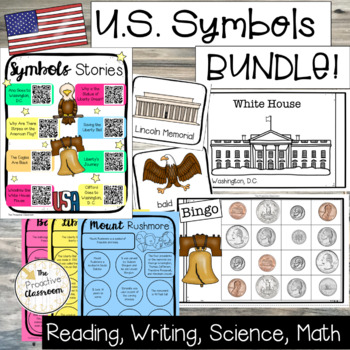U.S. (American) Symbols Thematic Unit for Reading, Writing, Math, Social Studies
The Proactive Classroom
3.8k Followers
Grade Levels
K - 2nd
Subjects
Resource Type
Standards
CCSSK.MD.A.2
CCSS1.MD.A.1
CCSS1.MD.A.2
CCSS1.OA.C.6
CCSSRL.1.1
Formats Included
- Zip
The Proactive Classroom
3.8k Followers
Products in this Bundle (8)
showing 1-5 of 8 products
Description
With this thematic unit, your students will experience and explore American symbols through reading, writing, listening to stories, measuring the symbols, exploring coins, and recording their learning. Click on each of the products to see more details about what it includes!
Total Pages
Answer Key
N/A
Teaching Duration
1 Week
Report this resource to TPT
Reported resources will be reviewed by our team. Report this resource to let us know if this resource violates TPT’s content guidelines.
Standards
to see state-specific standards (only available in the US).
CCSSK.MD.A.2
Directly compare two objects with a measurable attribute in common, to see which object has “more of”/“less of” the attribute, and describe the difference. For example, directly compare the heights of two children and describe one child as taller/shorter.
CCSS1.MD.A.1
Order three objects by length; compare the lengths of two objects indirectly by using a third object.
CCSS1.MD.A.2
Express the length of an object as a whole number of length units, by laying multiple copies of a shorter object (the length unit) end to end; understand that the length measurement of an object is the number of same-size length units that span it with no gaps or overlaps.
CCSS1.OA.C.6
Add and subtract within 20, demonstrating fluency for addition and subtraction within 10. Use strategies such as counting on; making ten (e.g., 8 + 6 = 8 + 2 + 4 = 10 + 4 = 14); decomposing a number leading to a ten (e.g., 13 - 4 = 13 - 3 - 1 = 10 - 1 = 9); using the relationship between addition and subtraction (e.g., knowing that 8 + 4 = 12, one knows 12 - 8 = 4); and creating equivalent but easier or known sums (e.g., adding 6 + 7 by creating the known equivalent 6 + 6 + 1 = 12 + 1 = 13).
CCSSRL.1.1
Ask and answer questions about key details in a text.





